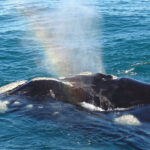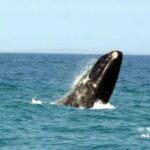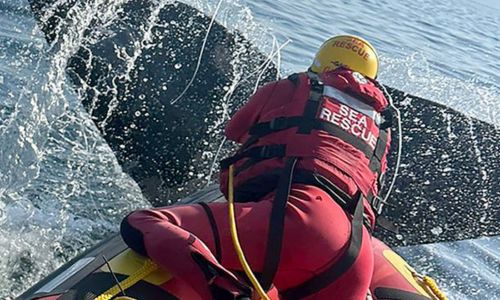 On Friday, 28 June, the SA Whale Disentanglement Network (SAWDN) was alerted to a Southern Right Whale in distress in Walker Bay, Hermanus, the land-based whale capital of the world.
On Friday, 28 June, the SA Whale Disentanglement Network (SAWDN) was alerted to a Southern Right Whale in distress in Walker Bay, Hermanus, the land-based whale capital of the world.
The whale was found entangled in what appeared to be a large amount of tuna monofilament long line entangled around its tail and flukes – it was evident that the line had embedded into the flesh.
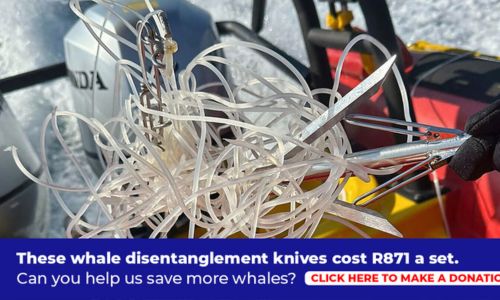 Approaching the whale cautiously, after several efforts to cut the fishing long line off the tail, the team used specialized cutting equipment to ensure the whale was released from this mobility-restrictive snare, and a large section of the line was successfully removed.
Approaching the whale cautiously, after several efforts to cut the fishing long line off the tail, the team used specialized cutting equipment to ensure the whale was released from this mobility-restrictive snare, and a large section of the line was successfully removed.
However, once the whale appeared to have greater maneuverability, having been freed of about 90% of the line with the remaining 10% staying in place due to the whale again disappearing under the surface.
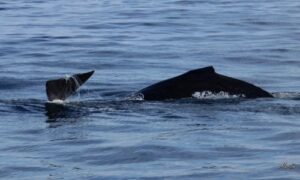 The whale was spotted again two days later moving in the direction of Gansbaai. NSRI caught up with the whale off-shore of Danger Point but it was decided that all resources to stand down due to the unfavorable sea conditions.
The whale was spotted again two days later moving in the direction of Gansbaai. NSRI caught up with the whale off-shore of Danger Point but it was decided that all resources to stand down due to the unfavorable sea conditions.
SOURCE + FULL STORY HERE
This sighting was very unique. Rarely, a Humpback whale and a Southern Right whale swim together.
Looking closely at the Southern Right Whale Tail the fishing line which entangled the whale is still visible.
 The South African Whale Disentanglement Network (SAWDN) was established in 2006 to manage entangled whales using specialized equipment and is comprised of trained volunteers from the – National Sea Rescue Institute, KwaZulu-Natal Sharks Board, Telkom Maritime Radio Services, Centre for Sustainable Oceans at the Cape Peninsula University of Technology, Cape Nature, Mammal Research Institute, South African National Parks, South African Police Service, Department of Environment Forestry and Fisheries, Cape Nature, Bayworld, various Boat Based Whale Watching and Shark Cage Diving Operators, the Rock Lobster Industry and the Octopus Industry and fully supported by the Dolphin Action and Protection Group.
The South African Whale Disentanglement Network (SAWDN) was established in 2006 to manage entangled whales using specialized equipment and is comprised of trained volunteers from the – National Sea Rescue Institute, KwaZulu-Natal Sharks Board, Telkom Maritime Radio Services, Centre for Sustainable Oceans at the Cape Peninsula University of Technology, Cape Nature, Mammal Research Institute, South African National Parks, South African Police Service, Department of Environment Forestry and Fisheries, Cape Nature, Bayworld, various Boat Based Whale Watching and Shark Cage Diving Operators, the Rock Lobster Industry and the Octopus Industry and fully supported by the Dolphin Action and Protection Group.
——————————————————————————–
What is whale disentanglement?
Unraveling the Mystery: Exploring the Vital Task of Whale Disentanglement
Whales are majestic creatures that roam the oceans, captivating and enchanting anyone lucky enough to catch a glimpse of them in their natural habitat. However, these magnificent animals are not immune to the dangers of human interference, with many falling victim to entanglement in fishing gear and other debris.
Whale disentanglement is the challenging and often dangerous task of freeing these massive marine mammals from their entanglements. It requires specialized training, equipment, and a great deal of skill and courage. It is a delicate operation that must be carried out with precision and care to avoid causing harm to the whale or endangering the rescuers.
The process typically involves approaching the trapped whale in a boat, like we see in the above article by the NSRI in South Africa, carefully assessing the situation, and then using specially designed tools to cut away the entangling ropes, nets, or other debris. It is a race against time, as entangled whales can suffer serious injuries or even death if not freed promptly.
The importance of whale disentanglement cannot be overstated. Not only does it help save the lives of individual whales, but it also contributes to the overall conservation and protection of these vulnerable species. By removing harmful debris from their bodies, rescuers can prevent further injury and ensure the whales have a fighting chance at survival in their challenging oceanic environment.
Despite the risks involved, dedicated teams of experts around the world continue to work tirelessly to rescue entangled whales and give them a second chance at life. Their efforts serve as a reminder of the profound impact that human actions can have on marine life, and the importance of taking responsibility for our role in protecting and preserving these magnificent creatures.
In a world where the future of our oceans is increasingly uncertain, the work of whale disentanglement teams offers a glimmer of hope and a powerful example of the difference that compassionate and dedicated individuals can make in the fight to save our planet’s precious marine ecosystems.


